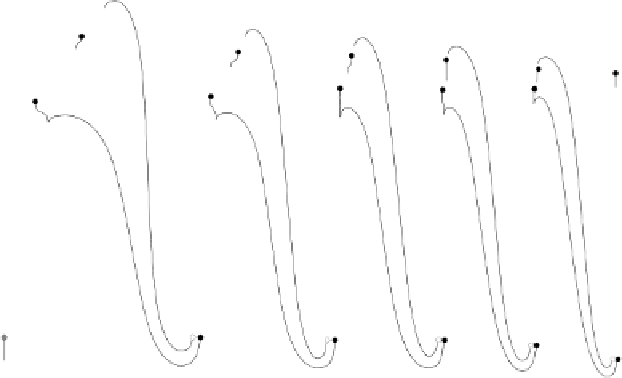Information Technology Reference
In-Depth Information
inhibitory
Feature sum
excitatory
Input
Layer 1
Layer 2
(8x8x16)
Layer 3
(4x4x32)
Layer 4
(2x2x64)
Layer 5
Layer 0 (32x32x4)
(16x16x8)
(1x1x128)
Fig. 5.1.
Learning a hierarchy of sparse features - network architecture. The Neural Abstrac-
tion Pyramid consists of six layers. Only forward projections are used. Excitation is specific
while unspecific inhibition is mediated by the subsampled smoothed feature sums.
that represents the subsampled sum of the features in the layer below. This feature
is inhibitory.
Patterns are presented to the input feature array located in the bottom layer of
the network. The input is analyzed by four excitatory feature arrays of Layer 0 that
compute center-surround features. They each have a single lateral projection with
direct access to the input array. The weights of these projections have a difference-
of-Gaussian structure with two different scales and two polarities. Fine and coarse
foreground and background features are detected. The projection unit has a linear
transfer function and contributes with weight one to the output unit which has a
saturating rectifying transfer function
f
p sat
(
α
= 1
, see Section 4.2.4) that limits
the activities to the interval
[0
,
1]
. This transfer function is also used for the output
units of the excitatory feature cells in the higher layers.
The feature sum
S
l
has only a single lateral projection with direct access to all
excitatory features of a layer. It weights the 3
×
3 neighborhood of its hypercolumn
with a binomial kernel that is scaled with a gain factor. The gain decreases with
height, such that the central weight decreases from 0.125 in Layer 0 to 0.015625 in
Layer 5. Both the transfer function of the projection unit and the one of its output
unit are linear. On the next higher layer the inhibitory feature array
S
l
computes the
average of a 2
×
2 window of
S
l
.
The basic processing elements used for the excitatory features in Layer 1 to
Layer 5 have two projections. One is the specific excitatory forward projection that
directly accesses overlapping 4
×
4 windows of all excitatory feature arrays in the
layer below. The other is the unspecific inhibitory projection that accesses the sub-



Search WWH ::

Custom Search